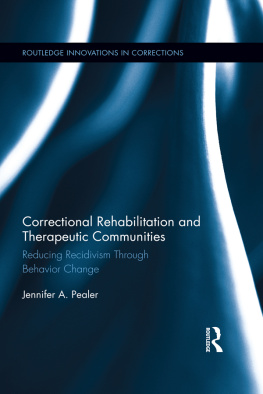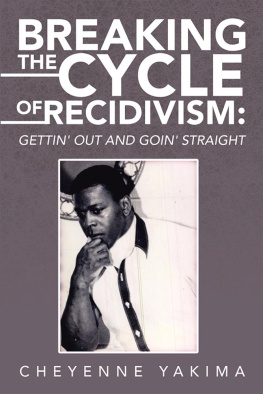Correctional Rehabilitation and Therapeutic Communities
Drawing on original research on the effectiveness of a therapeutic community (TC) in reducing recidivism among juvenile male offenders, Correctional Rehabilitation and Therapeutic Communities: Reducing Recidivism Through Behavior Change provides a comprehensive review of the current state of drug treatment for the offending population, especially the link between juvenile offending and substance abuse. The book assesses the factors predicting successful completion of treatment, as well as the methodological limitation of previous TC program reviews, and suggests policy implication and routes for future research.
Using improvements such as multiple outcome criteria, long-term follow-up, matching groups on risk and needs, and the employment of a standardized instrument to measure program quality, Correctional Rehabilitation assesses the degree to which participation in the TC affects antisocial attitudes and reduces delinquency. Readers will explore how TCs can be designed to influence adolescent drug offenders and ultimately reduce recidivism. This book is essential reading for students, researchers, practitioners, and other stakeholders focusing on the development of treatment programs.
Jennifer A. Pealer is an Assistant Professor in the Department of Criminal Justice and Criminology at East Tennessee State University (ETSU), where she teaches courses in corrections, juvenile justice, and statistics. Prior to joining ETSU, she was a Senior Policy Analyst with Council of State Governments Justice Center, where she assisted multiple states in implementing justice reinvestment legislation. She was also the Assistant Commissioner of Research and Program Development for the Kansas Juvenile Justice Authority, where she was responsible for developing, implementing, and overseeing evidence-based practices, programs, and training agendas. Dr. Pealer has served as a consultant to many correctional programs throughout the United States by providing training and technical assistance in offender risk/need instruments and effective practices in risk reduction and techniques for changing offending behavior. She has published articles in the field of correctional rehabilitation and public opinion on crime and correctional issues. She earned her B.A. and M.A. in criminal justice from East Tennessee State University and her Ph.D. in criminal justice from the University of Cincinnati.
Routledge Innovations in Corrections
An emphasis on innovation is evident in the field of corrections. While changes in policies and public opinion regarding sentencing philosophies such as mass incarceration bump up against the reality that budgets continue to be tightened and the division of these revenues is more competitive, innovative strategies become all the more valuable. The premise behind innovation is effecting improvements without sacrificing the over all safety and security of the institution. Through research and evaluation, we seek to identify what works and what does not work.
1 Hallett, The Angola Prison Seminary
Effects of Faith-Based Ministry on Identity Transformation, Desistance, and Rehabilitation
2 Shah, The Role of Rehabilitation within Californias Correctional System and Its Impact on Parole
3 Pealer, Correctional Rehabilitation and Therapeutic Communities
Reducing Recidivism Through Behavior Change
4 Ward, Rural Jail Re-entry: Offender Needs and Challenges
First published 2017
by Routledge
711 Third Avenue, New York, NY 10017
and by Routledge
2 Park Square, Milton Park, Abingdon, Oxon, OX14 4RN
Routledge is an imprint of the Taylor & Francis Group, an informa business
2017 Taylor & Francis
The right of Jennifer A. Pealer to be identified as author of this work has been asserted by her in accordance with sections 77 and 78 of the Copyright, Designs and Patents Act 1988.
All rights reserved. No part of this book may be reprinted
or reproduced or utilised in any form or by any electronic, mechanical, or other means, now known or hereafter invented, including photocopying and recording, or in any information storage or retrieval system, without permission in writing from the publishers.
Trademark notice: Product or corporate names may be trademarks or registered trademarks, and are used only for identification and explanation without intent to infringe.
Library of Congress Cataloging-in-Publication Data
Names: Pealer, Jennifer A., author.
Title: Correctional rehabilitation and therapeutic communities :
reducing recidivism through behavior change / Jennifer A. Pealer,
Department of Criminal Justice & Criminology, East Tennessee
State University.
Description: New York, NY : Routledge, 2017.
Identifiers: LCCN 2016045282 | ISBN 9781138288959 (hardback)
Subjects: LCSH: Juvenile delinquentsRehabilitationUnited
States. | Juvenile delinquentsBehavior modificationUnited
States. | Juvenile delinquentsDrug useUnited States. |
RecidivismUnited States.
Classification: LCC HV9104 .P43 2017 | DDC 365/.6610973dc23
LC record available at https://lccn.loc.gov/2016045282
ISBN: 978-1-138-28895-9 (hbk)
ISBN: 978-1-315-26753-1 (ebk)
Typeset in Sabon
by Apex CoVantage, LLC





